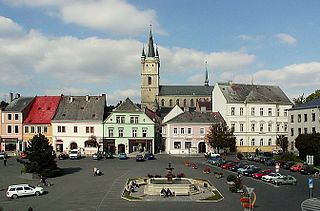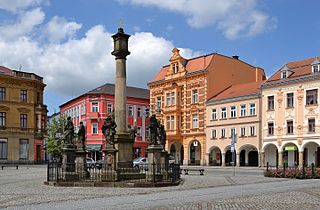
Prachatice is a town in the South Bohemian Region of the Czech Republic. It has about 11,000 inhabitants. The centre of the town is historically significant and is protected by law as Urban monument zone since 1981.

Tachov is a town in the Plzeň Region of the Czech Republic. It has about 13,000 inhabitants. It lies on the Mže River, some 55 km (34 mi) to the west from the region capital of Plzeň. The town centre is well preserved and is protected by law as an urban monument zone.

Polná is a town in Jihlava District in the Vysočina Region of the Czech Republic. It has about 5,200 inhabitants. The centre of the town is historically significant and is protected by law as urban monument zone.

Rumburk is a town in Děčín District in the Ústí nad Labem Region of the Czech Republic. It has about 11,000 inhabitants. It lies on the border with Germany. The town has a border crossing with the German town of Seifhennersdorf.

Klášterec nad Ohří is a town in Chomutov District in the Ústí nad Labem Region of the Czech Republic. It has about 14,000 inhabitants. The river Ohře flows through the town. The historic town centre is well preserved and is protected by law as an urban monument zone.

Vimperk is a town in the South Bohemian Region of the Czech Republic. It has approximately 7,400 inhabitants.

Stříbro is a town in Tachov District in the Plzeň Region of the Czech Republic. It has about 7,700 inhabitants. The town centre with the Renaissance Stříbro bridge is well preserved and is protected by law as an urban monument zone.

Roudnice nad Labem is a town in Litoměřice District in the Ústí nad Labem Region of the Czech Republic. It has about 13,000 inhabitants. It lies on the left bank of the Elbe river, 40 kilometres (25 mi) north of Prague. The town centre is well preserved and is protected by law as an urban monument zone.

Bor is a town in Tachov District in the Plzeň Region of the Czech Republic. It has about 4,500 inhabitants. It lies on the D5 motorway, some 50 km (30 mi) to the west from the region capital of Plzeň. The town centre is well preserved and is protected by law as an urban monument zone.

Březnice is a town in Příbram District in the Central Bohemian Region of the Czech Republic. It has about 3,500 inhabitants. The town centre is well preserved and is protected by law as an urban monument zone.

Jirkov is a town in Chomutov District in the Ústí nad Labem Region of the Czech Republic. It has about 19,000 inhabitants.

Vlachovo Březí is a town in Prachatice District in the South Bohemian Region of the Czech Republic. It has about 1,700 inhabitants. The town centre is well preserved and is protected by law as an urban monument zone.

Spálené Poříčí is a town in Plzeň-South District in the Plzeň Region of the Czech Republic. It has about 2,900 inhabitants. It lies some 20 km (12 mi) to the South-East from the region capital of Plzeň. The town centre is well preserved and is protected by law as urban monument zone.

Bavorov is a town in Strakonice District in the South Bohemian Region of the Czech Republic. It has about 1,600 inhabitants. The town centre is well preserved and is protected by law as an urban monument zone.

Kostelec nad Černými lesy, is a town in Prague-East District in the Central Bohemian Region of the Czech Republic. It has about 3,800 inhabitants. The town is part of the Prague metropolitan area. The town centre is well preserved and is protected by law as an urban monument zone.

Soběslav is a town in Tábor District in the South Bohemian Region of the Czech Republic. It has about 6,900 inhabitants. It is situated on the river Lužnice, 7 km northern from Veselí nad Lužnicí and 18 km southern from Tábor. The historical town centre is well preserved and is protected by law as urban monument zone.

Planá nad Lužnicí is a town in the South Bohemian Region of the Czech Republic. It has about 4,300 inhabitants. It is situated on the river Lužnice about 6 km south of Tábor and 11 km north of Soběslav. D3 motorway is being built east of the town.

Lomnice nad Popelkou is a town in Semily District in the Liberec Region of the Czech Republic. It has about 5,500 inhabitants. The town centre is well preserved and is protected by law as an urban monument zone, the local town part of Karlov is protected as a village monument reservation.

Osečná is a town in Liberec District in the Liberec Region of the Czech Republic. It has about 1,200 inhabitants.
St. Vitus Church in Český Krumlov, Czech Republic, is an important late-Gothic monument from 1407–1438, with later modifications. In 1995 it was declared a National Cultural Monument of the Czech Republic.

























